I found a bag of assorted crap. It’s the sort of crap you toss in a junk drawer and when you move out of your house, you shove it into a bag because you don’t have time to sort it out. It is such insignificant crap that you never bother to sort it out. So it sits around in a box, unseen for decades, until it becomes a little time capsule.
I started thinking about this sort of crap when I heard that Andy Warhol used to store boxes of assorted crap in his archives. He’d throw random things into a box and periodically send them off to storage. After he died, the boxes were opened and cataloged. One of the boxes contained a lost script by Valerie Solanas, she shot Warhol because he lost it. Oh well.
My bag of assorted crap is not as interesting as that. But since it is a collection of ephemera that has survived intact for so long, it deserves a closer examination.
So I’m going to present photos and document every single item in the bag. I did this once before. I took photos of a box of my childhood toys. I got an email from Rudy Rucker, he said he had boxes like that in his basement but he never knew what to do with them, now you just blog it and toss it out.
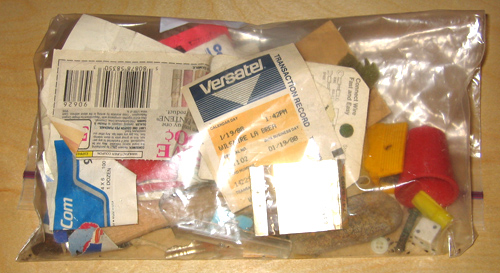
This is the unopened bag of crap. Click the link to see the rest of the photos.
Category: General
Apple’s Greatest Keyboard
John Gruber has been discussing (again) his preference for Apple’s older keyboards. I prefer Apple’s older keyboards too, because they stopped making their best keyboard. This is a huge gap in their product lineup.
Gruber prefers the ancient Apple Extended Keyboard II that was first released in 1990 and discontinued in 1999. Thomas Brand responded with claims the original Extended Keyboard from 1987 is superior. The differences between the models is subtle, but since the keyboard is a primary point of interaction with your computer, many people have strong opinions. And since this basic design was sold for more than 13 years, many people are very attached to these keyboards.
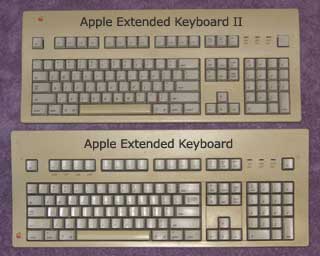
I even have an Extended II in my closet somewhere, and I remember using the original model back in 1987. These keyboards are massive, and were intended to compete with IBM’s famous Model M keyboard that first shipped in 1984.
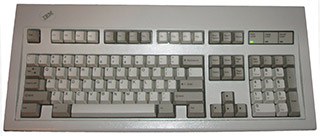
I sold hundreds, if not thousands of those keyboards from Apple and IBM, and it got me reminiscing about the keyboards I have used. And I came to the conclusion that keyboards probably shaped my career more than any other computer component.
The first computer keyboard I ever used was an IBM 029 Key Punch. I recently wrote about using a key punch back in late 1970 and early 1971, that was my first experience programming computers. I will never forget the sound of a room full of key punch machines, it was quite a racket. A key punch was incredibly difficult to use because you could not see what you were typing. The column you were typing on was under the punch mechanism. If you wanted to see what you had typed, you had to press a key and the card would pull back from under the mechanism so you could look at it.
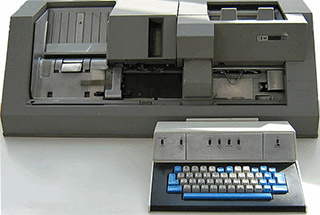
When I was in junior high school, I decided to take a typing class since keypunching was so difficult, one mistake and you ruined the card and had to start over. Typing class was considered vocational education for girls who wanted a career as a secretary and did not want to go to college. I mercilessly pounded away at the manual Olivetti typewriters for months and eventually achieved the 30 words per minute required to pass the typing class.
The next computer keyboard I encountered was a Teletype ASR-33. My dad got one for his flower shop so he could send and receive orders by Telex. I discovered it could connect to the University’s computers by modem at 110 baud. The keyboard had the strangest bouncy feel. You had to press hard until the solenoid activated and the key would spring back up as the machine typed the character on paper.
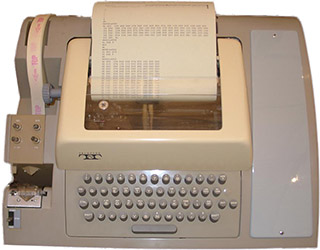
As I learned more about computers, I encountered many different keyboards. At first, they were printing terminals like the IBM 2741 “Selectric Terminal” or the DECwriter II. But soon I was using graphics terminals like the exotic (but clunky) PLATO IV and even the advanced Tektronix 4010 Vector Graphics Terminal. Oh there are too many to count, but I remember them all.
One keyboard stands out as exceptionally important to me. I have owned it for about 35 years, longer than any other keyboard. When I bought my first computer, I agonized over the keyboard. I wanted an Apple 1 but it came with no keyboard, you had to make your own. One of the few existing Apple 1 computers with a keyboard is in the Smithsonian Institution. It has a hand made wooden case and the right shift key is broken off. It looks like it was adapted from a Teletype, since it has strange keys like RUB OUT and HERE IS. I didn’t have any machines to cannibalize for parts, so I had no way to make something like this.

So instead of the Apple 1, I bought a SOL-20 kit which came with a pre-assembled keyboard. In retrospect, this was a poor choice. Both computers are considered collectible. An Apple 1 is worth tens of thousands of dollars in any condition, but my SOL is barely worth what I paid for it. And worst of all, every SOL keyboard rotted away with age after about 15 years. It took me many years to locate parts to fix the keyboard, but I finally managed to restore it back to working condition. For all that trouble, it would have been easier to build an Apple 1 keyboard myself.

The SOL keyboard was a strange design, it didn’t use standard key switches like the Apple II. Those keyboards really made my career as a computer tech. The key switches were durable but still broke a lot, especially when people pounded on the keys while playing games. Most shops could only replace the whole keyboard, which cost a lot of money. But I took the advanced repair class at Apple’s Texas factory and I learned how to replace an individual key switch. I recall the key switches only cost about a dollar, but there were 2 or 3 different types, and they weren’t interchangeable so I had to keep an assortment of keys in stock. I would replace keys for a flat rate, I don’t remember what I charged, but it was cheap compared to replacing the whole keyboard. I could disassemble the computer, pull out the keyboard, desolder the old key and put in a new one, then reassemble everything in about 15 minutes.
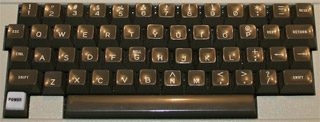
I made a lot of money replacing Apple II key switches. That really launched my career in computers. But I don’t want to reminisce about every keyboard I ever used over the decades. Let’s get back to Gruber’s keyboards.
Apple now makes only low profile aluminum keyboards, similar to the keyboards they use on laptops. They’re great keyboards and look beautiful, but Apple has made some changes that I don’t like. Now the Apple Wireless Keyboard is standard, but it’s not an extended keyboard with a numeric keypad and a full 109 keys.
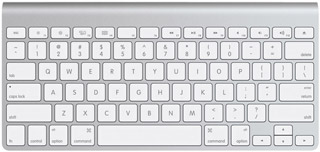
Apple does sell a full extended keyboard in the low profile aluminum style, but it’s not wireless. You have to plug it in with a USB cable. I didn’t realize how annoying this is until I got a wireless keyboard. And here is the problem: Apple does not make any full size wireless keyboards. If you want a full keyboard, you need to connect it wires. This is a huge gap in their product lineup.

The last full 109 key wireless keyboard was the Apple Bluetooth Keyboard, but it has been discontinued. That’s the keyboard I’m using right now. It’s probably the last keyboard Apple will ever make with full travel key switches. It’s going to be another classic that people will use for years and years. I bought mine in 2006.

But there’s one particularly annoying feature of this keyboard. It has a transparent plastic case. It looks beautiful when it’s new. But over time, keyboard crud falls through into the edges of the case and it looks awful. Some people recommend disassembling the keyboard and cleaning it in a dishwasher. I’m about ready to try it. Maybe it will be clean enough to work for another 6 years.
So people like me have a great attachment to their favorite keyboards. I completely understand Gruber’s love for his old Apple Extended II keyboard, and why he bought a spare to use if his current keyboard dies. I’m thinking of buying a spare Apple Bluetooth keyboard as a backup. Gruber thinks the Extended II is the best keyboard Apple ever made. I think the Bluetooth keyboard is the best Mac keyboard, Apple will probably never again make a anything as good as this.
But there is one keyboard that I consider the best keyboard Apple ever made, and the best keyboard ever, period. It is very rare, hardly anyone has ever touched one. But I used one at work every day. Notice it has two Apple keys on it, this foreshadowed the Mac’s Apple and Option keys. It was Apple’s first aluminum machine, it was solid as a rock and you could really pound the keys. The ergonomics were nearly perfect. I remember using a typing test program and after some practice, I got above 110 words per minute. I’ve never been able to surpass that speed on any kind of keyboard. That is what makes it the best keyboard ever, on any computer, it is the best tool for the job, especially if you’re good on a keyboard.

That is the keyboard from the Apple ///.
1971 – Learning FORTRAN Computer Programming
When I was 12 years old, I started learning to program computers. But in those days, that meant writing FORTRAN code on paper, then using a punch cards machine to encode it, and sending the deck of punch cards to the computer center. I recently found one of my first programs. It was a piece of 11×14 green bar paper wrapped around a thin stack of 26 cards, with a rubber band around it. It was wrapped in exactly the same way I would have received it back from the System Operators on January 14, 1971, except it’s a bit yellowed with age. The date printed on the paper is 71/014, the fourteenth day of 1971. That’s how computer time was calculated, if you wanted to convert that to a calendar date, you needed another computer program.
I unwrapped it and on top of the stack was my “separator card.” Programs were punched on white cards with a blue card on the top of each program. That is my 12 year old handwriting.
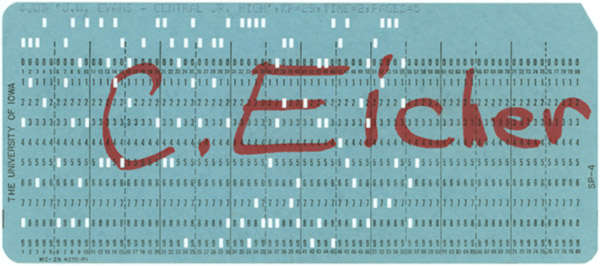
I saved a 1.2Mb PDF of the whole printout, but I’ll just show the important bits here. This is a really stupid program. But I suppose it’s not so bad for a 12 year old kid in 1971. Nowadays any 12 year old kid can write something more complex on a personal computer and get instant results. But back then, it took a full day to send the cards in and get a printout back.
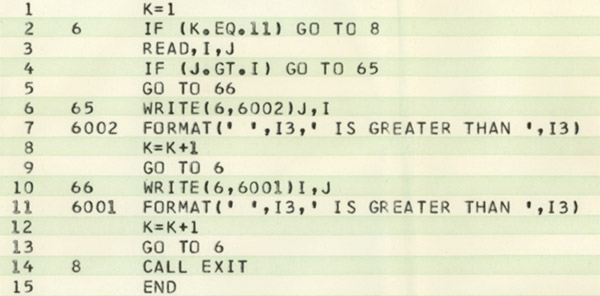
This must have been a class assignment to write a program that could compare two numbers punched on a card, and print which number was higher. But there are some really stupid programming tricks here. I’ll explain one and why it’s stupid. The program is designed to read a data card, compute which number is higher, print the results, and repeat until all 10 cards are done. It starts by setting a counter K to 1. After it prints each answer, it increments the counter, K=K+1 and loops back to the beginning to see if it should stop. But this is a stupid way to do it. The program stops when K gets to 11, which means the 10th card has been read, don’t read the 11th one, it isn’t there. But any normal computer programmer would have started with K=0, and count to 10, not 11. And the test for K>10 should be at the end, not the beginning of the program.
Now here are the results.
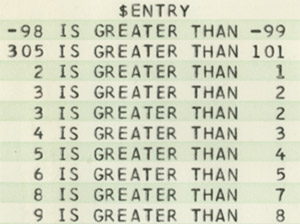
When I got this program back, I could not believe it. How could a computer possibly know which number was higher? I remember being baffled at my math teacher’s explanation, you subtract the second number from the first, and if the result is negative, the second one is greater. If positive, the first one is greater. But then, how does the computer know how to subtract? And how does it know if the result is positive or negative? Um.. that’s a little trickier. How do you know how to do that?
To me, the most interesting thing on this printout is at the bottom, where it lists the time the computer took to run this program. This was a huge IBM/360 mainframe costing millions of dollars. It took 0.13 seconds to compile the program, and 0.08 seconds to run. The blue card at the top of the program says to stop the program if it took more than 2 seconds to run. That would only happen if you got stuck in a loop and the program ran forever. Programs like that could stop a huge mainframe computer dead in its tracks, nothing would get done until that program was halted. I think I recall we got something like 2 seconds of computer runtime every semester, so one accident like that and you used up your whole semester’s worth of computer time in one shot. You’d have to beg the System Operators for more time, and apologize for your stupidity at wasting a whole two seconds, almost an eternity in IBM/360 time.
Blog Upgrade
I’m upgrading my blog to the newest version of MovableType. While I’m at it, I fixed my template, so the blog looks a lot better. As usual, there are still problems with the tricky bits like video.
1974: Broken Glass
Polaroid SX-70 print, circa 1974.
Assorted Scissors
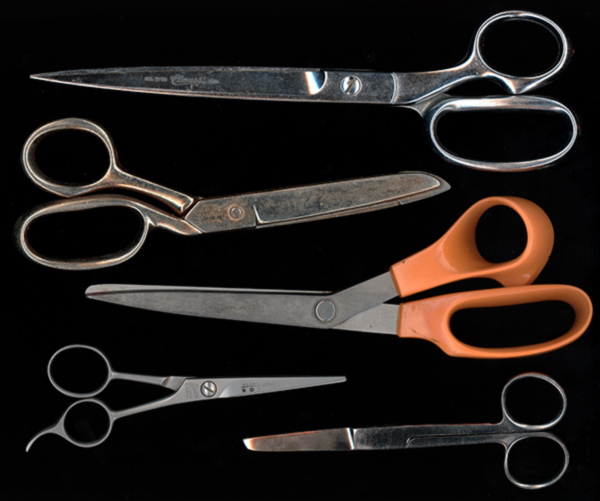
I have a lot of scissors. I put a few of them on my scanner, here they are from top to bottom.
Long scissors. Just over 9 inches long, with a 5.5 inch cutting blade. This scissors is very hard to use.
Heavy scissors. This scissors had a hard working life. It is rusty and corroded, and is too beat up to use. The side is stamped “Richards of Sheffield.”
Fiskars. Good general purpose scissors. Easy to use, I use it a lot.
Hair scissors. I don’t know why I have this, I wouldn’t trim my own hair.
Surgical Scissors. Very sharp and good for small, accurate cutting. I use this scissors the most.
LAN Template: 1988
I found an amusing old LAN design template. Yes, we used to design computer networks on paper. This template must date to about 1988, since the laser printer icon looks like an Apple LaserWriter II.
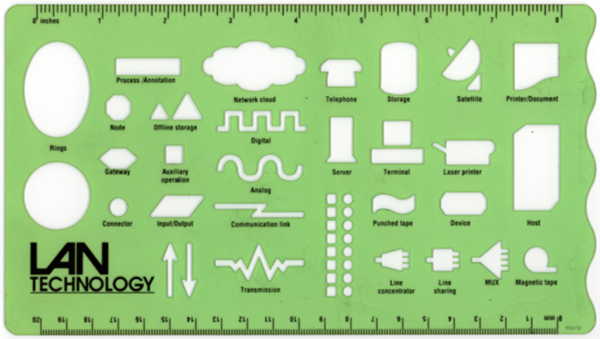
Polaroids: 1973~75
I found some dusty old SX-70 prints in my files. They’re in poor condition and were photographed sometime between 1973 to 1975. The first two are photographs of the Indianapolis 500. I didn’t notice until I scanned the first photo, you can see the Goodyear Blimp. That second shot has a nice pan and motion blur, that was really hard to do with the SX-70.
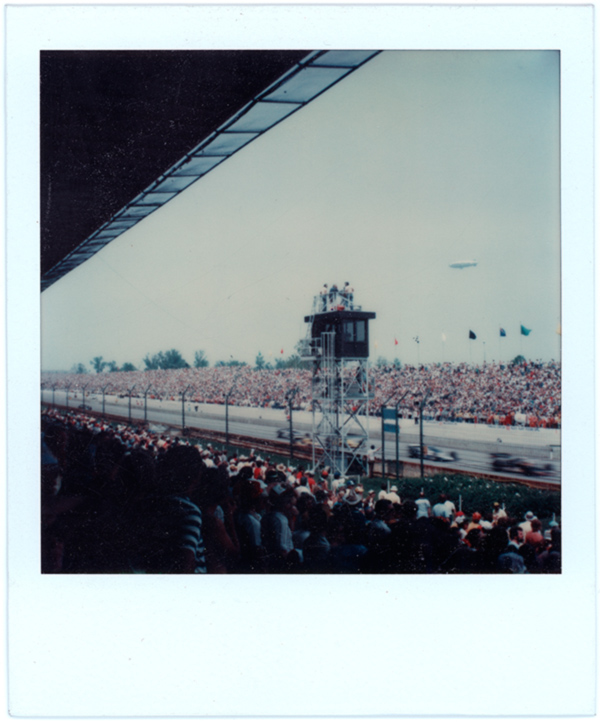
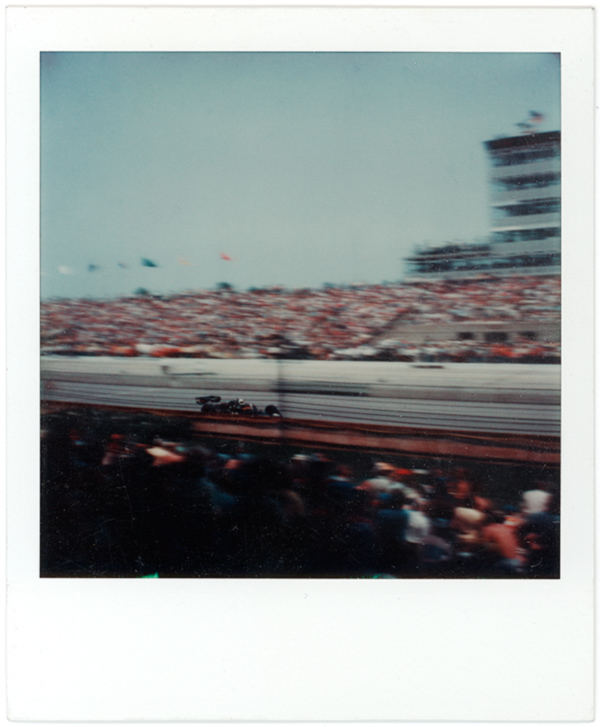
The next image had some cracks in the emulsion, I tried to fix it a little, but I left most of them unretouched. I’m finding out that SX-70 prints were not as indestructible as Polaroid claimed. But the subtle colors in the sky are pretty good.

I always liked the harsh look of the Polaroid Flash Bar, but they were really expensive. I liked using them at night, so the nearby objects were brightly lit, and the illumination quickly drops with distance.

Steve Jobs R.I.P.
![]()
The Great Firewall of China
Due to intense spam attacks on my blog, I have been forced to block access from every IP in China. In the last month, I have received over 16,000 spam comments, all of them originating from China. I don’t know what these spammers think they will achieve by spamming comments. They know they’re posting to a MovableType blog, which uses NoFollow, so none of the links in comments will improve their Google Pagerank. That’s usually the goal, and the NoFollow was implemented to thwart this. But still, they persist in this futile effort. Spammers are stupid.
So if you are from China and you have a compelling need to access my blog’s contents, too bad. Get your Chinese ISP to stop hosting spammers and maybe bloggers won’t be forced to lock you out.